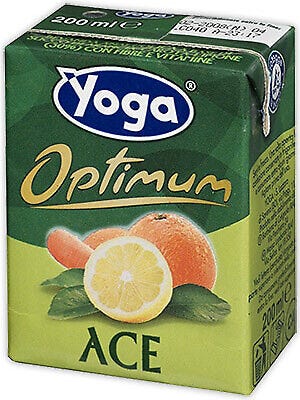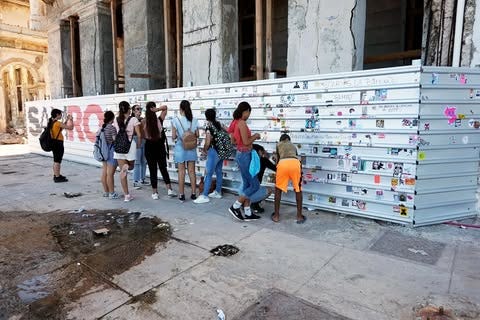In today’s letter I talk about stickers as an art form, museums scrapping entrance fees as a way to reduce costs, and as seems to often be the case, more disappointing AI news.
Sticker art and nostalgia
When I was in elementary school, my friends and I carried thick binders full of stickers that we would trade during recess. We’d sit cross-legged on the playground, sipping our ACE juices (Italian kids will know) and flipping through pages and pages, pointing out the stickers we wanted to trade while fiercely guarding the ones that were off-limits. We’d pass the time bargaining and haggling at school and then run home to beg our parents to give us whatever spare change they had so we could go buy new stickers to add to our collection. My most prized possession was a glittery blue ladybug, safely stored on the inside of a clear sheet protector.


I wonder if Italian artists PinoVolpino and Stelleconfuse also traded stickers in elementary school and that’s what prompted them to dedicate a museum to them. In 2022, the duo established the Sticker Art Museum Rome (SAMRO) in a phone booth in Rome. A relatively short-lived incipit, as the museum closed just over two months later, after an act of vandalism.
In March 2023, SAMRO reopened within the MAAM (Museo dell’Altro e dell’Altrove di Metropoliz - Città Meticcia) in Rome, transforming an unused space into a "matryoshka museum" - a museum within a museum - featuring stickers from over 200 artists worldwide.
Then, in 2024, came SAMRO’s international debut at the 15th Havana Biennial in Cuba, marking the first time sticker art was formally included in an official art event. A call for contributions went out on social media, and within just three months, over 250 artists from 35 countries sent in their stickers - enough to fill 15 kilograms of material bound for Havana. The original plan was to install a temporary exhibition along the iconic Malecón (a wall used for street art), but sadly, this installation was destroyed shortly after it was created.
No stranger to vandalism, SAMRO was able to find a new home in collaboration with students from the University of Havana, relocating to the Taller de Serigrafía René Portocarrero, a state-run printmaking workshop. There’s even a free-sticker area, where anyone can add their sticker art, which feels cathartic as someone who used to hog stickers and never actually stick them anywhere.
SAMRO’s mission, as described in their manifesto, is to:
“Serve as an international reference point for artists and fans of Sticker Art. SAMRO is committed to promoting knowledge, appreciation, and dissemination of Sticker Art primarily through its musealization, but also through a constantly updated archive, exhibitions, events, publications, and educational initiatives.”
Co-founder Stelleconfuse described SAMRO as being the embodiment of the idea that stickers deserve their own museum exhibition.
When I sit down to think about it, sticker collecting was my first approach to developing a sense of taste, and curating it. I would spend hours moving the stickers around my binder, and changing how to categorize them. I was drawn to certain motifs and shapes and colors more than others, and would trade away those stickers that didn’t fit that aesthetic, while trying to fill the gaps by acquiring those that could.
Stickers make up part of my personal heritage. Tangibly, they were my first approach to art. Intangibly, they carry a sense of nostalgia. When I go through any history museum today, I find everyday items from people who lived thousands of years ago and I like to think that thousands of years from now, people will visit their local museum and find stickers in the 'everyday objects' section.
Cultured published two articles that I loved this week, and they’re both about food. First is this interview to Zaynab Issa on Cultured magazine: “I became interested in food through the experience of women cooking. I appreciate the effort, whether it was a choice that they were consciously making or one that kind of happened to them”. The other is this conversation between artist Adam Pendelton and Chef Kwame Onuwachi. I’m always interested in reading more about how food and culture and art intersect - not only the dish itself but the act of cooking and sharing a meal with others.
, my very smart friend who writes , a very good newsletter about football and heritage, had some (very correct) thoughts about this $2.6B Manchester United stadium project.
The images I’ve seen have not just upset my footballing traditionalist sensibilities, but openly defiled them. This is a stadium that is more of Mordor than Manchester, a ludicrous space age confection draped in cling film.
[…]
Though I accept that change and stadium moves are inevitable, even necessary to keep serving fan communities, Manchester United’s new stadium project threatens the very qualities that give football its cultural meaning.
It is a project that can only be created by the neoliberal hellscape that is elite level English football.
It doesn’t seek to face, nurture and support a local community, but attract a global fanbase. It doesn’t seek to sustain a mutually beneficial network of local businesses, but to financially colonise the entire area – bringing the entire matchday experience under the money-grabbing umbrella of the club.
A new report suggests that if museums scrapped admission fees, it would drive greater attendance without raising costs for the museums. I’ve been shouting this from the rooftops for a while, I’m happy I’ve got more data to back it up now.
The Frick is reopening in April, following a $220M restoration.
Italy wants a bas-relief back from France and France wants the Statue of Liberty back from the USA.
Hilma af Klint’s works might be removed from public view. Erik af Klint, the artist’s great-grandnephew and board chair of the Hilma af Klint Foundation said that Hilma’s paintings should be held in a temple only open to “those who seek spiritual knowledge”. He also cited commercialization as a threat to the artist’s legacy. I got to see her Ten Largest at the Tate in London a few years ago, it definitely felt spiritual.
Museums are hanging paintings too high up. According to the article, this diminishes their impact, making them appear decorative and socially "unfriendly," as it excludes those who cannot comfortably view them. As a short person this was very funny to me.
Meta used pirated books to train its AI model. Library Genesis is a pirated database of millions of books, papers, and magazines and Meta’s communications about this decision were recently shared as part of a copyright infringement lawsuit filed against the company by multiple authors of books in LibGen’s database. Earlier this year, there was a similar lawsuit against OpenAI.
The Institute of Museum and Library Services has a new chief and a smaller budget.
UBS doesn’t know what to do with all the art it inherited from Credit Suisse. Who knew that post-acquisition integration would also mean having to deal with 13,500 artworks and a bunch of model ships.









